This section contains entries about our botanizing in Baja California written for the UC BEE (Oct 2012 to Aug 2021)
and The UC Bee Hive (2022-), monthly newsletters for volunteers and staff of the UC Berkeley Botanical Garden.
Click on any photo for a larger image.
MARCH BEE 2013
Plants in the Mulegé Oasis
Field Notes — Jan 12 - 23, 2013
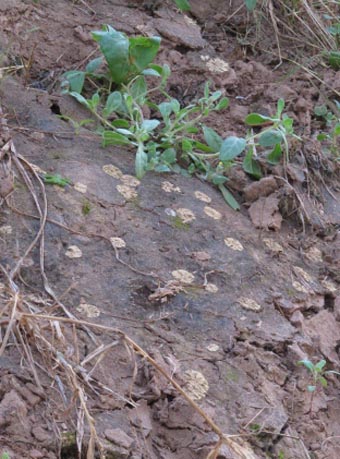 We have had very cold, gray weather during the last two weeks. While beach communities nearby have been enjoying highs into the 70's, in the Mulegé valley it has been gray skies and low temperatures dropping below 40 and barely rising above 60, putting the lie to Baja California Sur's reputation for having sunny, mild winters. This past week, people were taken completely by surprise by the ice covering their car windows downtown, and some of the crops farther out in the valley sustained frost damage, adding to the economic woes of farmers who just lost their first round of crops in the October flood. It’s also rained twice this month, not the drenching monsoonal type rains, but winter’s typical equipatas, a light rain that lasts a few hours and has time to soak into the ground.
We have had very cold, gray weather during the last two weeks. While beach communities nearby have been enjoying highs into the 70's, in the Mulegé valley it has been gray skies and low temperatures dropping below 40 and barely rising above 60, putting the lie to Baja California Sur's reputation for having sunny, mild winters. This past week, people were taken completely by surprise by the ice covering their car windows downtown, and some of the crops farther out in the valley sustained frost damage, adding to the economic woes of farmers who just lost their first round of crops in the October flood. It’s also rained twice this month, not the drenching monsoonal type rains, but winter’s typical equipatas, a light rain that lasts a few hours and has time to soak into the ground.
The rain and cold weather has certainly helped shady areas along the river banks and in the palm orchards to retain their moisture. The bryophytes in the ditch I’ve been monitoring are still green, and many patches of moss are growing quite large. However, the liverworts (Riccia cavernosa, photo right) are dying back, many having turned into yellow circles on the ground that, like rotting leaves, are slowly disappearing into the soil. Cool-season annuals continue to proliferate and prosper while most shrubs and trees, though leafy, are just biding their time for warmer weather and spring flowering.
Mulegé River (El Ojo de Agua)
On the 12th, we finally made it for the first time to the Ojo de Agua, or headwater of the Mulegé River, located within the palm grove. Following the course of the river upstream along the bank a short distance, we reached the spot where the river abruptly ends at a dense stand of Carrizo or Giant Reed (Arundo donax). Looking into the shallow water at the Ojo, you can often see bubbles or underwater currents created by the fresh water seeping out of the ground. The river then flows approximately one mile above-ground before it drops several feet into the brackish water of the estuary and continues for another mile to the Gulf of California.
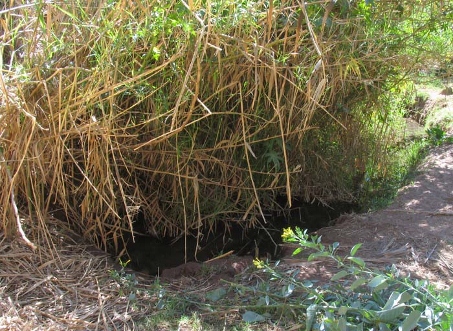
The origin (Ojo) of the above-ground, fresh water portion of the Río Mulegé, March 2011.
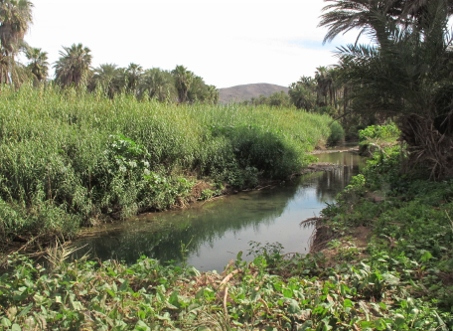
Almost the exact spot (about 3 m to the right), December 2013.
I had expected to see a lot of changes in the topography near the Ojo compared to the past few years, and indeed there was a major restructuring of the banks and many of its shrubs and trees. The channel is now much wider and the dense canopy which just last year tightly overhung the narrow channel is no longer present. The only part that looked mostly unchanged was the east bank which is covered in a dense, wide stand of Carrizo, though its edge has been lopped off by two to three meters. It has not been easy to repeat photos of some locations I previously photographed over the course of several years, because some features are just no longer there.
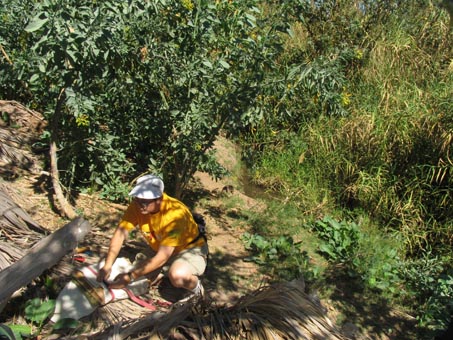
Where I am closing up my plant press here in March 2011 is now the the center of the gravel bar in the photo at right >>>
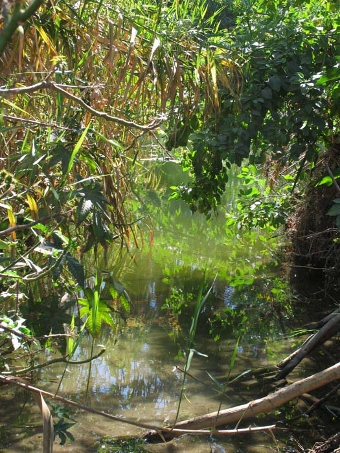 Dense canopy of Carrizo and Baccharis salicifolia in March 2011.
Dense canopy of Carrizo and Baccharis salicifolia in March 2011.
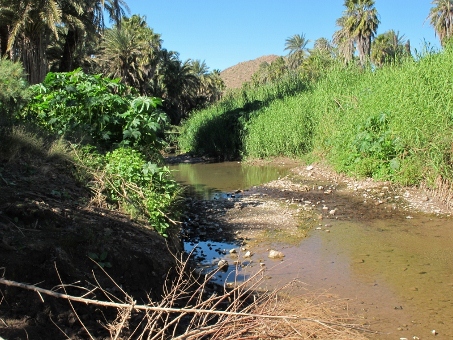
The clump of Carrizo in the middle distance with the shadow is the same clump in shadow in the photo above, but now seen from the other side (December 2013).
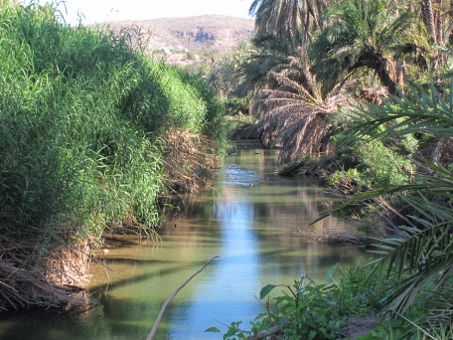
Photo taken from the same spot in December 2013.
The river banks are lined with Schoenoplectus americanus (Junco), Baccharis salicifolia (Guatamote, Mulefat), low growing Anemopsis californica (Yerba Mansa), Bacopa monnieri, Eclipta prostrata, Cyperus elegans (Junco), and numerous other annual herbs that are all vying for space and resources on the newly opened up river banks. Hidden among the leaves and stems of these calf-high plants were hundreds upon hundreds of mounds of bright green mosses and liverworts (Riccia cavernosa). The mosses appear similar to those I have already collected at the ditch (see Jan. Bee).
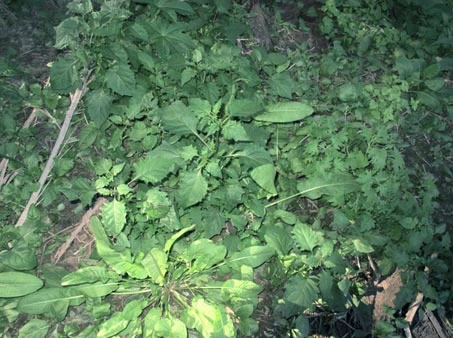
Sprouts of the weedy non-native Solanum americanus and Physalis pubescens vie for light along the shady river bank. The plant in the foreground, just off-center appears to belong in the Polygonaceae (Buckwheat family) and is likely a species of Rumex (Dock) but I'm waiting for the plant to develop further.
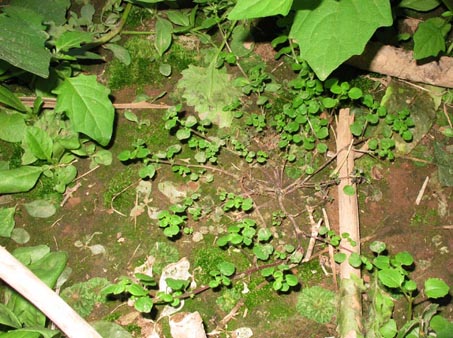
It was hard to decide what to step on and what to spare as we tried to move through the dense vegetation in search of new species. Here several species of moss and the liverwort Riccia cavernosa fill in spaces between plants.
Field Notes — Jan 28 - Feb 13, 2013
Unfortunately, we don’t seem to be the only ones interested in the lush growth at the Ojo. Many of the plants along the river are obviously quite palatable since on our return just a couple of weeks later, it looked like a weed whacker had been through in some places, leaving many plants chomped off mid-stem or stripped of most of their leaves. I didn’t realize that even Castor bean seedlings (Ricinis communis) are in high demand (the seeds are highly toxic). So, it’s now a race against the local herds of goats to see who will be first to lay claim to a number of as-yet unidentified species. How long do I dare wait? Will they even get a chance to flower, and will I be able to get to those that do in time? We shall see…
Before I go, an update on the plant inventory: I've again added several new species to the list. The ditch has been incredibly productive and last week we came across yet another species of Erythranthe [Mimulus] (Monkeyflower) bringing the total for the site to three (see Feb. entry). The newest species, Erythranthe dentilobus, is a prostrate annual that looks very similar to Erythranthe brevinasuta. It differs by having a prostrate habit, and is somewhat hairy with very distinctive toothed corolla lobes.
.jpg)
Prostrate, spreading habit of Erythranthe [Mimulus] dentilobus (Toothpetal Monkey-flower). Plant is about 25 cm D.
.jpg)
Erythranthe [Mimulus] dentilobus. Flower dimensions: c. 1 cm L x 6-7 mm D.
Stay tuned for next month's entry...
— Debra Valov, curatorial volunteer











.jpg)
.jpg)